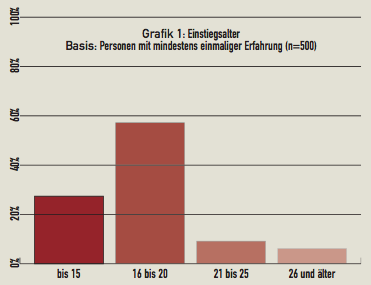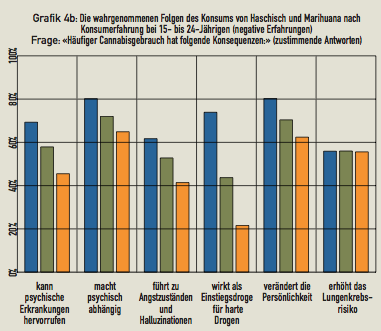- THC & Law:
Cannabis study part 2
After the Swiss Center for Alcohol and Other Drug Problems (SFA) published its cannabis study in February and various results have already been reported in Legalize It! 18, the following is mainly about experiences with and opinions about the use of cannabis.
Numbers and opinions
In recent months, the mass media have also published one or the other figure from this study when it came to describing the group of pot smokers. The bare numbers are still the easiest and quickest thing to have at hand. So, for the time being, the ostensibly most important questions have been answered. I do believe, however, that people interested in cannabis want to take a closer look at their stimulant - contrary to certain prejudices. Thus, a view focused more on opinions than on numerical quantities also seems interesting. What experiences have cannabis users had and what opinions do they have in common with each other and with non-users or not?
Use vs. abuse
When it comes to the use of cannabis, not only concerned parents and teachers often ask about the dangers of abuse that could lead to worse. However, as is the case with illegalized cannabis products, by law any use becomes abuse. Thus, from the health-preventive point of view, only a part of the whole situation can be judged. Thus, I feel that the division into legal and illegal drugs - especially in the case of cannabis - is a hindrance for everyone involved when it comes to solving problems. But also from a “pure” health point of view, it is difficult to make statements about the effect of cannabis and THC in particular, since this is all very individual, as we know.
Thus, also in the text of the SFA it is stated that there is no agreement about which form and which frequency of cannabis use is to be called abusive (daily use is called “problematic”). International studies are mentioned - the Roque study (F) and the Kleiber study (D) - “which prove that the health risk from cannabis use is to be classified as low and the toxicity of cannabis is less than that of alcohol, for example”.
However, there are also reports of an increasing number of young people who have already tried cannabis. However, the proportion of “potential abusers” (i.e. daily smokers) has not increased to the same extent. Thus, the so-called quitting rate - the proportion of “quitters” who give up smoking pot over time - still seems to be considerable: While more than 15% of 15- to 19-year-olds (with cannabis experience) use at least daily, the figure is just under 10% for 20- to 24-year-olds and still a good 5% for 25- to 44-year-olds. For the SFA, there is no question that “daily smoking has an unfavorable effect on the psychosocial development of adolescents (young people; editor's note) in particular.”
It is therefore quite clear that, from a health perspective, (young) adolescents are the most important target group. It is important to inform these young people as well as possible, so that they know what they are dealing with when it comes to cannabis - and what are rather horror stories. The efforts of not only these experts are also aimed at ensuring that the use of cannabis is not started too early and that it is then better not practiced on a daily basis. Even if these goals are plausible, it can be assumed that the repression and its consequences massively complicate the work in the field of prevention.
Age of first consumption
“When did you smoke your first joint?” This question has certainly come up in many conversations - and not just in so-called “stoner circles.” Most could certainly tell long stories about what “the first time” was like: what people were involved and the exact environment in which it happened.
 |
Estimating the average age of first use is difficult, according to the SFA text, and even more so is the shift in that age over time. Recent calculations have shown “that the age of first use has decreased by about three-quarters of a year in recent years and should be placed between 15 and 16 years.” Nearly 60% of the 15- to 19-year-olds surveyed placed their first cannabis use before the age of 15, while the corresponding figure for 20- to 24-year-olds is still just over a quarter.
Do you have a problem?
For the authors of the study it is immediately obvious that the use of cannabis can bring problems. According to the study, one fifth of the younger respondents with cannabis experience also perceived problems.
 |
Reference is also made to the fact that not only psychological and physical problems were perceived, but the respondents also noticed social difficulties. However - and here I am really grateful - it is immediately added that this is not a consequence of the effect of THC, but rather a consequence of the illegal status of cannabis products. This could also be an explanation for the fact that more problems are perceived in French-speaking Switzerland (D-CH: 10.3%, F-CH: 21.6% and I-CH: 10.3%).
The striking difference between the young and the older is attributed in the text to the fact that “the unpleasant sides of consumption fade after a while of years.” However, I find this explanation to be minimalist. I would say that users of cannabis also adopt a personal pattern of norms and rules, a culture, in other words, that “regulates” the use of the stimulant - in such a way that it is not perceived as problematic. Secondly, people of a higher age who smoke pot are no longer “under observation” in the same way as students whose cannabis use has been noticed and who are punished. Young people are most likely to perceive their cannabis use as a source of friction between the world of youth and adult society. Perhaps in later life it is the physical and psychological problems that begin to replace those with parents, teachers and the police?
What is the benefit of smoking pot?
Why do people actually smoke pot? An interesting and yet difficult question to answer. But since there does seem to be a huge amount of people who get something out of consuming cannabis products, the text to the study also points out the socio-political importance of drugs in general. “They not only provoke intoxication and ecstasy, promise new feelings and artificial paradises, but they also help to displace frustration and suffering and can even be used as a remedy. What is true of drugs in general is also true of cannabis.”
 |  |
It quickly becomes apparent that non-users cannot easily comprehend the recreational aspect of smoking pot (recreational pleasure and against everyday stress); only a few can even imagine that cannabis is used as a remedy. Most current users, on the other hand, do not perceive cannabis as a “protest drug”. This image from rebellious years is still attached to hash and weed, although after decades of increasing repression a new category could be created - that of the “martyr drug” cannabis.
What are the consequences of smoking pot?
The consequences attributed to cannabis use were divided into three independent dimensions for the survey: A positive experience aspect ( Graph 4a), a negative experience aspect (Graph 4b), and a performance aspect (Graph 4c).
 |  |
 |  |
Similar to the use value of cannabis, non-users cannot relate to the increase in creativity through cannabis use, for example. On the negative side, the eternal myth of cannabis as a gateway drug also resurfaces. The discussions on this topic are endless - the results of the study on this issue are refreshingly clear in this respect.
If the results are not evaluated according to cannabis experience but according to age and thus refer to the total sample, it becomes apparent that the young assign significantly more positive consequences to cannabis use than older persons. The negative aspects, however, are not ignored by the younger ones. Young people even perceive the consequences in terms of performance more critically, which leads the SFA to conclude that young users are probably better informed, not least because of educational drug prevention.
... I still have one
In two articles have now but numerous results of this cannabis study in the Legalize it! found place. In another (and last) article, the image of the smokers and cannabis-political opinions of the respondents will be discussed. Until then, hopefully new facts will arrive from the Federal House about the political processes - let's wait and see.
Source: “Cannabis on the threshold of becoming a legal intoxicant: a representative study on the phenomenon “cannabis” : consumption, attitudes, politics” by Richard Müller, Hermann Fahrenkrug, Sandra Müller. SFA, Swiss Center for Alcohol and Other Drug Problems, 2001. (books.google.ch - PDF)
Support our work with a donation:
Bank transfer
Account number (IBAN):
CH02 0900 0000 8709 1354 3
Full account details
Or scan this QR code with your eBanking App (ZKB, Revolut, Postfinance, …):

Or open/share the QR code as PDF file with your eBanking App.
Credit card
Donate via credit card
Verein Legalize it!
Quellenstrasse 25
8005 Zürich
Threema ID 7NH65RBY
Don’t miss anything! Follow us on social media:

